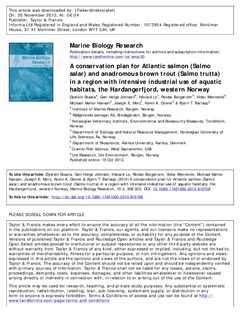| dc.contributor.author | Skaala, Øystein | |
| dc.contributor.author | Johnsen, Geir Helge | |
| dc.contributor.author | Lo, Håvard | |
| dc.contributor.author | Borgstrøm, Reidar | |
| dc.contributor.author | Wennevik, Vidar | |
| dc.contributor.author | Hansen, Michael Møller | |
| dc.contributor.author | Merz, Joseph E. | |
| dc.contributor.author | Glover, Kevin A. | |
| dc.contributor.author | Barlaup, Bjørn T. | |
| dc.date.accessioned | 2013-11-20T14:08:07Z | |
| dc.date.available | 2013-11-20T14:08:07Z | |
| dc.date.issued | 2013-10-15 | |
| dc.identifier.citation | Øystein Skaala, Geir Helge Johnsen, Håvard Lo, Reidar Borgstrøm, Vidar Wennevik, Michael Møller Hansen, Joseph E. Merz, Kevin A. Glover & Bjørn T. Barlaup (2014) A conservation plan for Atlantic salmon (Salmo salar) and anadromous brown trout (Salmo trutta) in a region with intensive industrial use of aquatic habitats, the Hardangerfjord, western Norway, Marine Biology Research, 10:3, 308-322, DOI: 10.1080/17451000.2013.810758 | no_NO |
| dc.identifier.issn | 1745-1019 | |
| dc.identifier.issn | 1745-1000 | |
| dc.identifier.uri | http://hdl.handle.net/11250/109051 | |
| dc.description.abstract | Extensive use of aquatic habitats, mainly for hydropower and aquaculture, has a negative impact on anadromous salmonid populations of the Hardangerfjord region, western Norway. High infection levels of salmon lice, and high proportions of escaped farmed salmon in spawning rivers, appear to violate the goals in the Strategy for an Environmentally Sustainable Aquaculture Industry' set by the Norwegian government. An overview of the anadromous populations in the fjord, their status and the major threats are presented. A conservation plan with mitigation efforts consisting of seven steps is presented: (1) genetic assessment of Atlantic salmon and anadromous brown trout populations, (2) reducing gene flow from escapees, (3) reducing infection pressure from salmon lice, (4) conduct an assessment of the freshwater habitats for anadromous salmonids and then implement it in order to restore smolt production, (5) efforts to reduce risk of river pollution from agriculture and industry and minimize impacts from hydropower production, (6) when and where necessary and practical, plant out eyed eggs from the Norwegian Genebank to increase parr and smolt production, and finally, (7) monitor spawning populations and parr densities to evaluate potential effects of the mitigation efforts. Experience and knowledge gained through the plan will be useful for other regions with similar challenges. We call for an initiative to establish a national fund under democratic and public control, where funding can be obtained for projects which focus on mitigation efforts and conservation of salmonid populations. | no_NO |
| dc.language.iso | eng | no_NO |
| dc.publisher | Taylor & Francis | no_NO |
| dc.title | A conservation plan for Atlantic salmon (Salmo salar) and anadromous brown trout (Salmo trutta) in a region with intensive industrial use of aquatic habitats, the Hardangerfjord, western Norway | no_NO |
| dc.type | Journal article | no_NO |
| dc.type | Peer reviewed | no_NO |
| dc.subject.nsi | VDP::Agriculture and fishery disciplines: 900::Fisheries science: 920::Aquaculture: 922 | no_NO |
| dc.source.pagenumber | 308-322 | no_NO |
| dc.source.volume | 10 | no_NO |
| dc.source.journal | Marine Biology Research | no_NO |
| dc.source.issue | 3 | no_NO |
| dc.identifier.doi | 10.1080/17451000.2013.810758 | |
| dc.relation.project | Research Council of Norway:188955/130 | no_NO |
